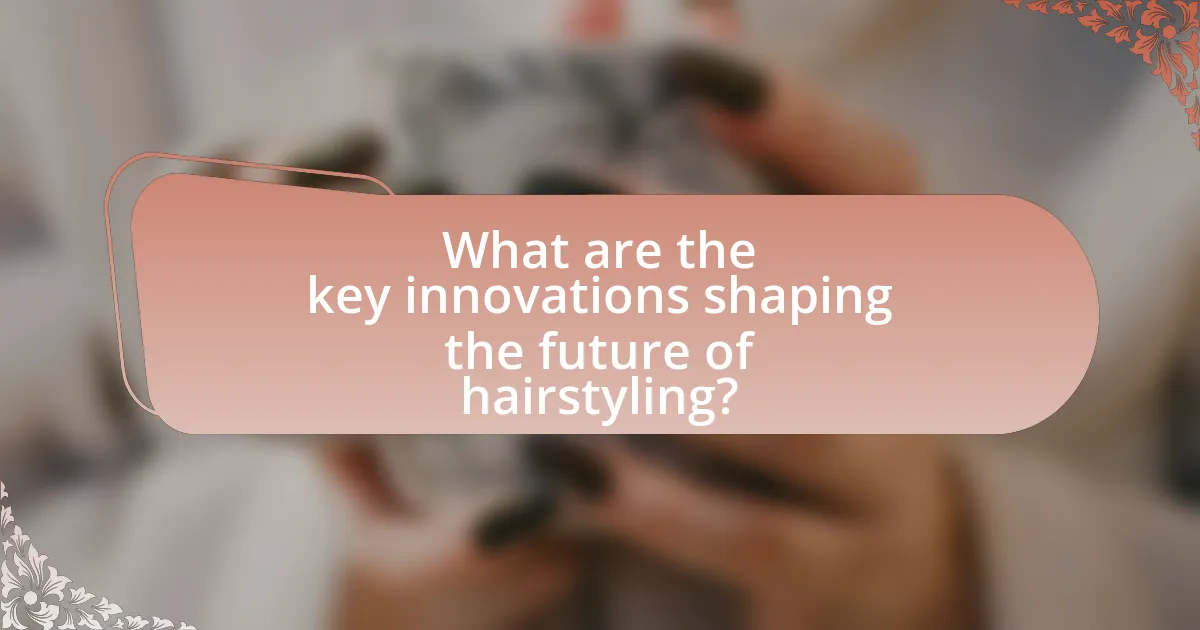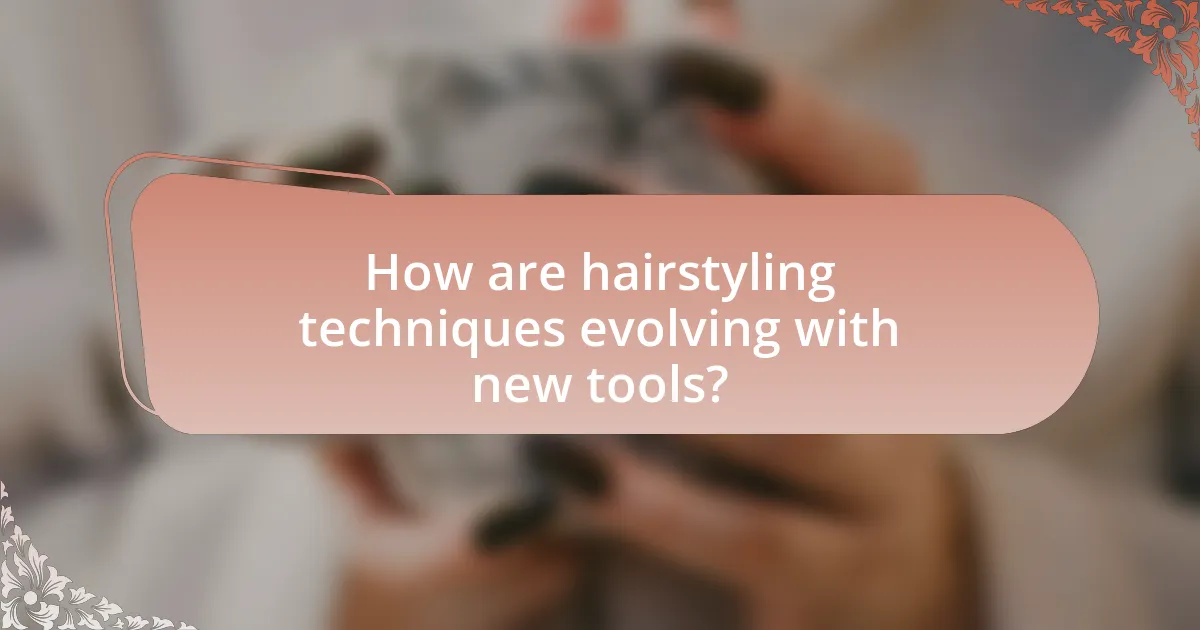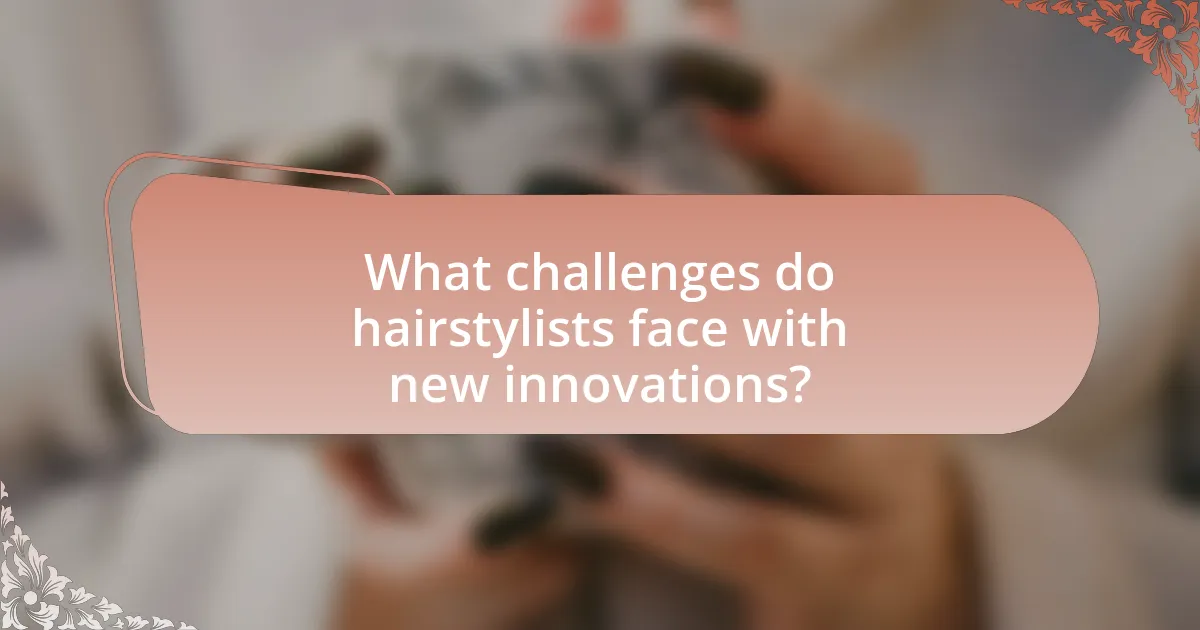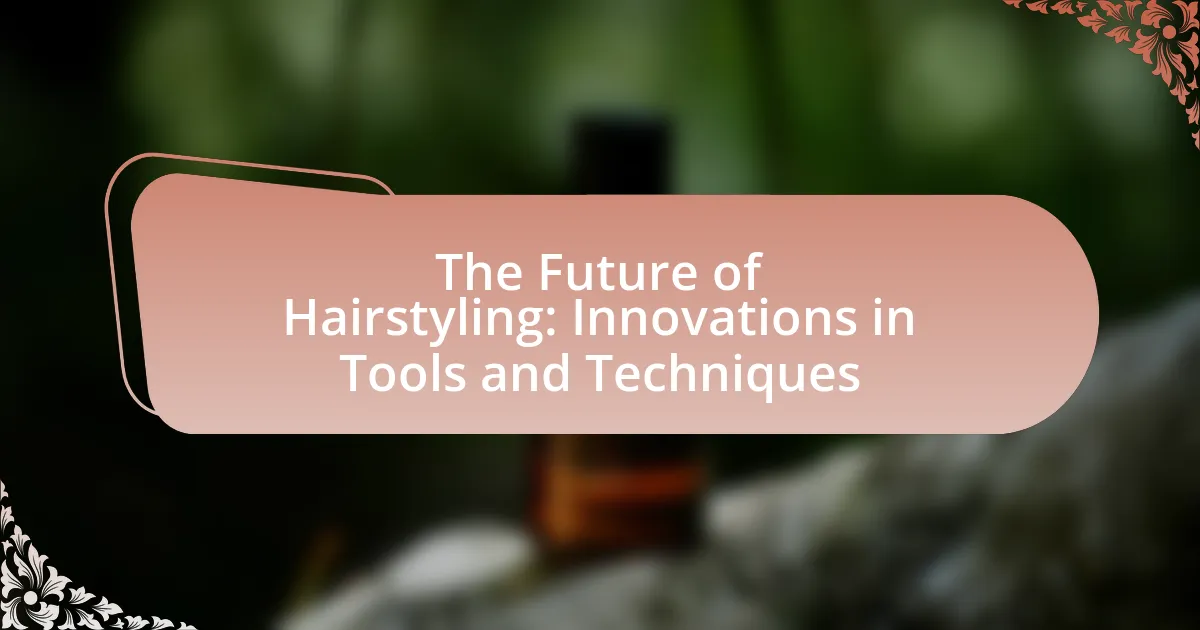The article focuses on the future of hairstyling, highlighting key innovations in tools and techniques that are transforming the industry. It discusses advanced hair tools that incorporate smart technology and improved materials, enhancing styling efficiency and hair health. The article also explores personalized hair care technology, sustainable practices, and the impact of social media trends on hairstyling techniques. Additionally, it addresses the challenges hairstylists face in adapting to these innovations and offers insights into best practices for utilizing new tools effectively. Overall, the content emphasizes the importance of continuous education and adaptation in a rapidly evolving hairstyling landscape.

What are the key innovations shaping the future of hairstyling?
Key innovations shaping the future of hairstyling include advanced hair tools, personalized hair care technology, and sustainable practices. Advanced hair tools, such as smart hairdryers and styling devices that utilize AI to optimize heat and airflow, enhance styling efficiency and hair health. Personalized hair care technology leverages data analytics and genetic testing to create customized hair products tailored to individual needs, improving overall hair quality. Sustainable practices, including eco-friendly products and biodegradable packaging, are increasingly adopted in the industry, reflecting consumer demand for environmentally responsible options. These innovations collectively transform hairstyling into a more efficient, personalized, and sustainable experience.
How are technological advancements influencing hairstyling tools?
Technological advancements are significantly enhancing hairstyling tools by introducing features such as smart technology, improved materials, and energy efficiency. For instance, tools like hair dryers and straighteners now incorporate sensors that adjust heat settings based on hair type, reducing damage and improving styling efficiency. Additionally, innovations in materials, such as ceramic and titanium, provide better heat distribution and durability, leading to superior performance. According to a report by Grand View Research, the global hair styling tools market is projected to reach $25.5 billion by 2025, driven by these technological improvements.
What new materials are being used in hairstyling tools?
New materials being used in hairstyling tools include advanced ceramics, titanium, and tourmaline. Advanced ceramics provide even heat distribution and reduce damage to hair, while titanium is known for its durability and lightweight properties, allowing for quick heating and styling. Tourmaline, a semi-precious stone, is often used in hair dryers and flat irons to emit negative ions, which help reduce frizz and enhance shine. These materials are increasingly favored for their performance and ability to protect hair health during styling.
How do smart technologies enhance hairstyling experiences?
Smart technologies enhance hairstyling experiences by providing personalized solutions and improving efficiency through advanced tools. For instance, smart hairdryers and straighteners equipped with sensors can adjust temperature and airflow based on hair type, minimizing damage and optimizing styling results. Additionally, apps that analyze hair condition and suggest tailored products or styles further personalize the experience. According to a report by Grand View Research, the global smart hair care market is expected to grow significantly, indicating a rising trend in the integration of technology in hairstyling. This data underscores the effectiveness of smart technologies in transforming hairstyling into a more customized and efficient process.
What role do sustainable practices play in hairstyling innovations?
Sustainable practices are integral to hairstyling innovations as they drive the development of eco-friendly products and techniques. These practices encourage the use of biodegradable materials, organic ingredients, and energy-efficient tools, which reduce environmental impact. For instance, the rise of brands like Aveda, which utilizes plant-based ingredients and sustainable packaging, exemplifies how the industry is shifting towards greener alternatives. Additionally, innovations such as waterless hair care products and energy-efficient styling tools reflect a commitment to sustainability, aligning with consumer demand for environmentally responsible choices. This shift not only enhances brand reputation but also meets regulatory standards aimed at reducing waste and carbon footprints in the beauty industry.
How are eco-friendly products changing the hairstyling industry?
Eco-friendly products are transforming the hairstyling industry by promoting sustainable practices and reducing environmental impact. These products, such as biodegradable shampoos and organic hair dyes, are gaining popularity among consumers who prioritize health and sustainability. According to a 2021 survey by Statista, 60% of consumers are willing to pay more for eco-friendly beauty products, indicating a significant market shift. This change encourages brands to innovate and develop greener formulations, leading to a broader acceptance of sustainable practices within salons and among hairstylists. As a result, the hairstyling industry is increasingly aligning with eco-conscious values, fostering a culture of responsibility and care for the planet.
What are the benefits of using sustainable hairstyling tools?
Sustainable hairstyling tools offer environmental benefits, reduce waste, and promote health. These tools are often made from eco-friendly materials, which minimizes the carbon footprint associated with production and disposal. For instance, tools made from bamboo or recycled plastics contribute to less deforestation and plastic pollution. Additionally, sustainable tools often utilize energy-efficient technologies, which can lower energy consumption during use. Studies indicate that using eco-conscious products can lead to a healthier salon environment, reducing exposure to harmful chemicals for both stylists and clients.

How are hairstyling techniques evolving with new tools?
Hairstyling techniques are evolving significantly due to the introduction of advanced tools such as digital styling devices, heat protectant technologies, and automated styling machines. These innovations enhance precision, reduce styling time, and minimize hair damage. For instance, tools like smart hair straighteners can adjust temperature based on hair type, ensuring optimal styling without excessive heat exposure. Additionally, automated curling wands allow for consistent curls with minimal effort, reflecting a shift towards user-friendly designs that cater to diverse hair textures and styles. The integration of technology in hairstyling not only improves results but also empowers users to achieve professional-quality looks at home.
What are the latest trends in hairstyling techniques?
The latest trends in hairstyling techniques include the use of sustainable products, personalized hair care routines, and advanced heat styling tools. Sustainable products are gaining popularity as consumers increasingly prioritize eco-friendly options, leading brands to develop biodegradable and cruelty-free formulations. Personalized hair care routines leverage technology, such as AI-driven consultations, to tailor treatments to individual hair types and concerns, enhancing effectiveness. Additionally, advanced heat styling tools, like smart hair dryers and curling wands with temperature control, minimize damage while maximizing styling efficiency, reflecting a shift towards healthier hair practices. These trends are supported by market research indicating a growing consumer demand for sustainability and personalization in beauty products.
How do modern techniques differ from traditional methods?
Modern techniques in hairstyling differ from traditional methods primarily through the use of advanced technology and innovative tools. For instance, modern hairstyling often incorporates digital tools such as 3D hair simulation software and heat styling tools with precise temperature control, which enhance the accuracy and efficiency of styling. Traditional methods typically rely on manual techniques and basic tools, which can be less efficient and more time-consuming. Additionally, modern techniques emphasize personalized approaches, utilizing data-driven insights to tailor styles to individual preferences, whereas traditional methods often follow standardized practices. This shift towards customization is supported by the rise of social media platforms, where trends can rapidly evolve, influencing hairstyling techniques in real-time.
What impact do social media trends have on hairstyling techniques?
Social media trends significantly influence hairstyling techniques by promoting new styles and techniques that quickly gain popularity among users. Platforms like Instagram and TikTok showcase viral hairstyles, leading hairstylists to adopt these trends to meet client demands. For instance, the rise of the “Wolf Cut” and “Curtain Bangs” on social media has prompted salons to offer specialized services for these styles, reflecting a shift in hairstyling practices. Additionally, tutorials and influencer endorsements on social media platforms provide hairstylists with innovative techniques and inspiration, enhancing their skill sets and service offerings. This dynamic interaction between social media and hairstyling techniques illustrates how digital trends shape the industry, driving both creativity and consumer engagement.
How is education adapting to new hairstyling tools and techniques?
Education is adapting to new hairstyling tools and techniques by integrating advanced technology into curricula and training programs. Institutions are incorporating digital platforms, such as virtual reality and augmented reality, to simulate hairstyling scenarios, allowing students to practice with innovative tools in a controlled environment. Additionally, updated course materials now include the latest trends and techniques, ensuring that students are familiar with contemporary products and methods. For instance, many cosmetology schools have begun to offer workshops on the use of smart tools, like heated styling devices with temperature control, which enhance styling precision and safety. This approach not only equips students with practical skills but also prepares them for a rapidly evolving industry that increasingly relies on technological advancements.
What training is available for new hairstyling technologies?
Training for new hairstyling technologies includes specialized courses offered by beauty schools, online platforms, and industry workshops. These programs focus on the latest tools, techniques, and trends in hairstyling, such as advanced cutting methods, color application, and the use of innovative styling tools. For instance, many beauty schools have updated their curricula to incorporate training on digital tools like virtual hair color simulators and advanced hair extension techniques. Additionally, organizations like the Professional Beauty Association provide resources and certification programs that emphasize the importance of staying current with technological advancements in hairstyling.
How are hairstylists incorporating new tools into their skill sets?
Hairstylists are incorporating new tools into their skill sets by actively engaging in training programs and workshops that focus on the latest technologies and techniques. For instance, many hairstylists are learning to use advanced tools such as digital hair color mixers and automated styling devices, which enhance precision and efficiency in their work. According to a survey by the Professional Beauty Association, 65% of hairstylists reported that they have adopted new tools in the past year, indicating a strong trend towards modernization in the industry. This integration not only improves service quality but also allows hairstylists to offer innovative styles that meet evolving client demands.

What challenges do hairstylists face with new innovations?
Hairstylists face several challenges with new innovations, primarily including the need for continuous education and adaptation to new tools and techniques. As technology evolves, hairstylists must invest time and resources into learning how to effectively use advanced equipment, such as digital hair color mixers or automated styling tools. This requirement for ongoing training can be a financial burden, as many stylists operate in a competitive market where client retention is crucial. Additionally, there is often a learning curve associated with new innovations, which can temporarily impact service quality and client satisfaction. According to a survey by the Professional Beauty Association, 70% of stylists reported feeling overwhelmed by the rapid pace of technological advancements in their field, highlighting the significant pressure to keep up with industry changes.
How do hairstylists adapt to rapidly changing technologies?
Hairstylists adapt to rapidly changing technologies by continuously updating their skills and incorporating new tools into their practices. They engage in ongoing education through workshops, online courses, and industry events to stay informed about the latest trends and innovations. For instance, the introduction of digital tools like virtual hair color simulators and advanced styling equipment has prompted hairstylists to learn how to use these technologies effectively. Additionally, many hairstylists utilize social media platforms to showcase their work and connect with clients, which requires them to be proficient in digital marketing techniques. This adaptability is essential for maintaining competitiveness in a fast-evolving industry.
What are the common obstacles in adopting new hairstyling tools?
Common obstacles in adopting new hairstyling tools include high costs, lack of training, and resistance to change. High costs can deter hairstylists and consumers from investing in innovative tools, as many new products are priced significantly higher than traditional options. Lack of training often leads to underutilization of advanced features, as hairstylists may feel unprepared to use new technology effectively. Resistance to change is prevalent in the hairstyling industry, where established practices and tools are deeply ingrained, making professionals hesitant to transition to unfamiliar methods. These factors collectively hinder the widespread adoption of new hairstyling tools.
How can hairstylists overcome resistance to change?
Hairstylists can overcome resistance to change by actively engaging in continuous education and training on new tools and techniques. This approach not only enhances their skill set but also builds confidence in adopting innovative practices. Research indicates that salons that prioritize ongoing education experience a 30% increase in employee satisfaction and retention, as stylists feel more competent and valued. By fostering a culture of adaptability and open communication, hairstylists can effectively address concerns and demonstrate the benefits of change, leading to a more progressive and innovative salon environment.
What are the best practices for utilizing new hairstyling tools?
To effectively utilize new hairstyling tools, users should prioritize understanding the specific features and functionalities of each tool. Familiarizing oneself with the manufacturer’s instructions ensures safe and optimal use, as many tools come with unique settings tailored for different hair types and styles. Additionally, practicing on a small section of hair before full application allows users to gauge the tool’s performance and adjust techniques accordingly. Research indicates that proper heat settings can prevent hair damage; for instance, using lower temperatures for fine hair and higher for coarse hair can enhance results while maintaining hair health. Regular maintenance of tools, such as cleaning and checking for wear, also contributes to their longevity and effectiveness.
How can hairstylists ensure client satisfaction with new techniques?
Hairstylists can ensure client satisfaction with new techniques by actively communicating with clients about their preferences and expectations before implementing any changes. This approach allows hairstylists to tailor their services to meet individual client needs, which is crucial for satisfaction. Research indicates that effective communication enhances client trust and leads to better outcomes in service industries, including hairstyling. By discussing the benefits and potential results of new techniques, hairstylists can set realistic expectations, thereby increasing the likelihood of client satisfaction.
What tips can hairstylists follow to stay updated on innovations?
Hairstylists can stay updated on innovations by actively participating in industry events, such as trade shows and workshops. These events provide firsthand exposure to the latest tools, techniques, and trends in hairstyling. Additionally, hairstylists should subscribe to professional magazines and online platforms that focus on hair care and styling innovations, ensuring they receive regular updates on new products and methods. Engaging with online communities and social media groups dedicated to hairstyling can also facilitate knowledge sharing and networking with other professionals. Research indicates that continuous education and networking are crucial for staying competitive in the beauty industry, as they allow stylists to adapt to evolving consumer preferences and technological advancements.


